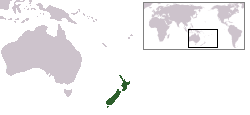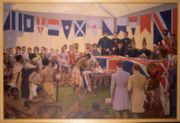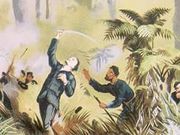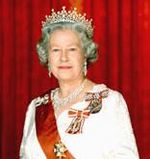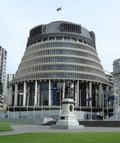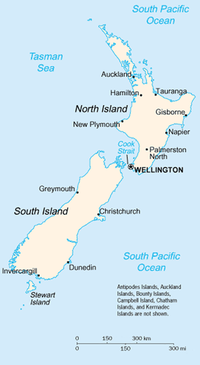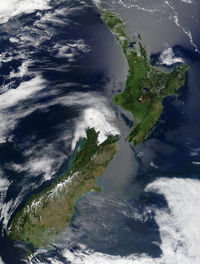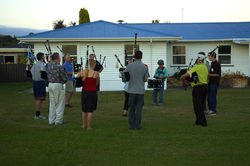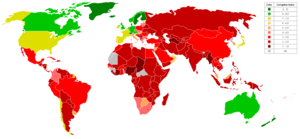New Zealand
2007 Schools Wikipedia Selection. Related subjects: Countries; Geography of Oceania (Australasia)
| New Zealand Aotearoa ( Māori) |
|||||
|
|||||
| Motto: none (formerly "Onward") | |||||
| Anthem: God Defend New Zealand God Save The Queen1 |
|||||
| Capital | Wellington |
||||
|---|---|---|---|---|---|
| Largest city | Auckland2 | ||||
| Official languages | English3, Māori, New Zealand Sign Language |
||||
| Government | Constitutional monarchy | ||||
| - Head of State | Queen Elizabeth II | ||||
| - Governor-General | Anand Satyanand | ||||
| - Prime Minister | Helen Clark | ||||
| Independence | |||||
| - from the UK | September 26, 19074 | ||||
| Area | |||||
| - Total | 268,680 km² ( 75th) 103,738 sq mi |
||||
| - Water (%) | 2.1% | ||||
| Population | |||||
| - March 2006 estimate | 4,147,9725 ( 124th in 2005) | ||||
| - 2006 census | 4,116,9006 | ||||
| - Density | 15/km² ( 193rd) 39/sq mi |
||||
| GDP ( PPP) | 2005 estimate | ||||
| - Total | 101.685 billion USD7 ( 58th) | ||||
| - Per capita | 24,797 USD8 ( 27th) | ||||
| HDI (2003) | 0.933 (high) ( 19th) | ||||
| Currency | New Zealand dollar ( NZD) |
||||
| Time zone | NZST9 ( UTC+12) | ||||
| - Summer ( DST) | NZDT (Oct-Mar) ( UTC+13) | ||||
| Internet TLD | .nz | ||||
| Calling code | +64 | ||||
| 1 God Save The Queen is officially a national anthem but is generally used only on regal and vice-regal occasions. 2 Auckland is the largest urban area; Auckland City is the largest incorporated city. 3 English is a de facto official language; the other two have de jure official status. 4 There is a multitude of dates that could be considered to give independence. (See Independence of New Zealand.) 5 6 Provisional 2006 census night population figure, which has limitations 7 Year to March 2006 GDP was 155.763 billion NZD 8 Year to March 2006 GDP per capita was 37,896 NZD 9 The Chatham Islands have a separate time zone, 45 minutes ahead of the rest of New Zealand |
|||||
New Zealand is a country in the southwestern Pacific Ocean comprising two large islands (the North Island and the South Island) and numerous smaller islands, most notably Stewart Island and the Chatham Islands. In Māori, New Zealand is also known as Aotearoa, which is usually translated into English as the Land of the Long White Cloud.
The Realm of New Zealand also includes the Cook Islands and Niue, which are self-governing, but in free association; Tokelau; and the Ross Dependency (New Zealand's territorial claim in Antarctica).
New Zealand, Hawai'i and Rapa Nui (Easter Island) form what is known by anthropologists as the Triangle of Polynesia.
New Zealand is notable for its geographic isolation, being separated from Australia to the northwest by the Tasman Sea, some 2000 kilometres (1250 miles) across. Its closest neighbours to the north are New Caledonia, Fiji, and Tonga.
The population is mostly of European descent, with the indigenous Māori being the largest minority. Non-Māori Polynesian and Asian people are also significant minorities, especially in the cities.
Elizabeth II, as the Queen of New Zealand, is the Head of State and is represented, in her absence, by a non-partisan Governor-General; the Queen 'reigns but does not rule', so she has no real political influence. Political power is held by the democratically-elected Parliament of New Zealand under the leadership of the Prime Minister who is the Head of Government.
History
New Zealand is one of the most recently settled major land masses. Polynesian settlers arrived in their waka some time between the 11th century and the 13th century to establish the indigenous Māori culture. New Zealand's Māori name, Aotearoa, is usually translated as "Land of the long white cloud", reputedly referring to the cloud the explorers saw on the horizon as they approached. Settlement of the Chatham Islands to the east of the mainland produced the Moriori people; linguistic evidence, in particular the innovations uniquely shared by the Moriori and Māori languages, indicates that they moved there from New Zealand. Most of New Zealand was divided into tribal territories called rohe, resources within which were controlled by hapū ('subtribes'). Māori adapted their tropically-based culture to eating the local marine resources, flora and fauna for food. They also hunted the giant flightless moa (which soon became extinct). They showed great ingenuity in adapting their tropical agricultural technology to a temperate climate, successfully cultivating taro, gourds, kumara (sweet potato), and other plants which they introduced from Polynesia; it is thought that kūmara were grown as far south as Banks Peninsula in the middle of the South Island. While it was fairly easy to grow these crops in the north, these warm-climate crops were impractical in the south of the South Island. However, inter-regional trade and the exploitation of the few food plants of the local flora made up the difference. They also introduced other plants such as the paper mulberry or 'aute', used to make barkcloth for kites and for personal adornment.
The first Europeans known to have reached New Zealand were led by Abel Janszoon Tasman, who sailed up the west coasts of the South and North Islands in 1642. He named it Staten Landt, believing it to be part of the land Jacob Le Maire had seen in 1616 off the coast of Chile. Staten Landt appeared on Tasman's first maps of New Zealand, but this was changed by Dutch cartographers to Nova Zeelandia, after the Dutch province of Zeeland, some time after Hendrik Brouwer proved the supposedly South American land to be an island in 1643. The Latin Nova Zeelandia became Nieuw Zeeland in Dutch. Captain James Cook subsequently called the archipelago New Zealand (a slight corruption, as Zealand is not an alternative spelling of Zeeland, a province in the Netherlands, but of Sjælland, the island in Denmark that includes Copenhagen), although the Māori names he recorded for the North and South Islands (as Aehei No Mouwe and Tovy Poenammu respectively) were rejected, and the main three islands became known as North, Middle and South, with the Middle Island being later called the South Island, and the earlier South Island becoming Stewart Island. Cook began extensive surveys of the islands in 1769, leading to European whaling expeditions and eventually significant European colonisation. From as early as the 1780s, Māori had encounters with European sealers and whalers. Acquisition of muskets by those iwi in close contact with European visitors destabilised the existing balance of power between Māori tribes and there was a temporary but intense period of bloody inter-tribal warfare, known as the Musket Wars, which ceased only when all iwi were so armed.
Concerned about the exploitation of Māori by Europeans, the British Colonial Office appointed James Busby as British Resident to New Zealand in 1832. In 1834, Busby convened the United Tribes of New Zealand to select a flag and declare their independence, which led to the Declaration of the Independence of New Zealand. This declaration did not allay the fears of the Church Missionary Society, who continued lobbying for British annexation. Increasing French interest in the region led the British to annex New Zealand by Royal Proclamation in January 1840. To legitimise the British annexation, Lieutenant Governor William Hobson had been dispatched in 1839; he hurriedly negotiated the Treaty of Waitangi with northern iwi on his arrival. The Treaty was signed in February, and in recent years it has come to be seen as the founding document of New Zealand. The Māori translation of the treaty promised the Māori tribes " tino rangatiratanga" would be preserved in return for ceding kawanatanga, which the English version translates as "chieftainship" and "sovereignty"; the real meanings are now disputed. Disputes over land sales and sovereignty caused the New Zealand land wars, which took place between 1845 and 1872. In 1975 the Treaty of Waitangi Act established the Waitangi Tribunal, charged with hearing claims of Crown violations of the Treaty of Waitangi. Some Māori tribes and the Moriori never signed the treaty.
New Zealand was initially administered as a part of the colony of New South Wales, and it became a separate colony in November 1840. The first capital was Okiato or old Russell in the Bay of Islands but it soon moved to Auckland. European settlement progressed more rapidly than anyone anticipated, and settlers soon outnumbered Māori. Self-government was granted to the settler population in 1852. There were political concerns following the discovery of gold in Central Otago in 1861 that the South Island would form a separate colony, so in 1865 the capital was moved to the more central Wellington. New Zealand was involved in a Constitutional Convention in March 1891 in Sydney, New South Wales, along with the Australian colonies. This was to consider a potential constitution for the proposed federation between all the Australasian colonies. New Zealand lost interest in joining Australia in a federation following this convention.
In 1893 New Zealand became the first nation to grant women the right to vote on the same basis as men; however, women were not eligible to stand for parliament until 1919.
New Zealand became an independent dominion on 26 September 1907, by Royal Proclamation. Full independence was granted by the United Kingdom Parliament with the Statute of Westminster in 1931; it was taken up upon the Statute's adoption by the New Zealand Parliament in 1947. Since then New Zealand has been a sovereign constitutional monarchy within the Commonwealth of Nations.
New Zealand was one of the first to join the Allies when it declared war on Germany on 3 September 1939, along with France, the United Kingdom, Australia and Canada after the invasion of Poland. New Zealand troops fought in North Africa, Greece, Crete, Italy and in the Pacific. The navy and airforce were also involved.
In 1951, Australia, New Zealand and the United States formally became allies with the signing of the ANZUS Treaty. In 1985, New Zealand declared itself a nuclear-free zone. As a result, US warships could no longer enter New Zealand ports without declaring themselves to be free of nuclear weapons or power. As such a declaration would be against US Government policy, effectively the ships were banned from New Zealand. The United States suspended its obligations to New Zealand under the ANZUS Treaty.
Government
New Zealand is a constitutional monarchy with a parliamentary democracy. Under the New Zealand Royal Titles Act ( 1953), Queen Elizabeth II is Queen of New Zealand and is represented as head of state by the Governor-General, currently Anand Satyanand.
New Zealand is the only country in the world in which all the highest offices in the land have been occupied simultaneously by women, between March 2005 and August 2006 - The Sovereign, Queen Elizabeth II; Governor-General Dame Silvia Cartwright; Prime Minister Helen Clark; Speaker of the New Zealand House of Representatives Margaret Wilson; and Chief Justice Dame Sian Elias.
The New Zealand Parliament has only one chamber, the House of Representatives, which usually seats 120 Members of Parliament. Parliamentary general elections are held every three years under a form of proportional representation called Mixed Member Proportional. The 2005 General Election created an ' overhang' of one extra seat, occupied by the Māori Party, due to that party winning more seats in electorates than the number of seats its proportion of the party vote would have given it.
There is no written constitution: the Constitution Act 1986 is the principal formal statement of New Zealand's constitutional structure. The Governor-General has the power to appoint and dismiss Prime Ministers and to dissolve Parliament. The Governor-General also chairs the Executive Council, which is a formal committee consisting of all ministers of the Crown. Members of the Executive Council are required to be Members of Parliament, and most are also in Cabinet. Cabinet is the most senior policy-making body and is led by the Prime Minister, who is also, by convention, the Parliamentary leader of the governing party or coalition.
The current Prime Minister is Helen Clark, leader of the Labour Party. She is serving her third term as Prime Minister. On 17 October 2005 she announced that she had come to a complex arrangement that guaranteed the support of enough parties for her Labour-led coalition to govern. The formal coalition consists of the Labour Party and Jim Anderton, the Progressive Party's only MP. In addition to the parties in formal coalition, New Zealand First and United Future provide confidence and supply in return for their leaders being ministers outside cabinet. A further arrangement has been made with the Green Party, which has given a commitment not to vote against the government on confidence and supply. This commitment assures the government of a majority of seven MPs on confidence.
The Leader of the Opposition, National Party leader Don Brash, formerly Governor of the Reserve Bank announced his resignation on November 23, 2006. Although John Key seems the most likely candidate to replace Brash, it is unknown whether this will be the case. The ACT party and the Māori Party are both also in opposition. The Greens, New Zealand First and United Future all vote against the government on some legislation.
Major political parties:
- Labour Party (50 seats)
- National Party (48 seats)
Minor political parties (in Parliament):
- ACT New Zealand (2 seats)
- Green Party (6 seats)
- Jim Anderton's Progressive Party (1 seat)
- Māori Party (4 seats)
- New Zealand First (7 seats)
- United Future (3 seats)
The highest court in New Zealand is the Supreme Court of New Zealand, which was established in 2004 following the passage of the Supreme Court Act 2003. The Act abolished the option to appeal Court of Appeal rulings to the Privy Council in London. The current Chief Justice is Dame Sian Elias. New Zealand's judiciary also includes the High Court, which deals with serious criminal offences and civil matters, and the Court of Appeal, and subordinate courts.
Foreign relations and the military
New Zealand maintains a strong profile on environmental protection, human rights and free trade, particularly in agriculture.
New Zealand is a member of the following geo-political organisations: APEC, East Asia Summit, Commonwealth of Nations, OECD and the United Nations. It has signed up to a number of free trade agreements, of which the most important is Closer Economic Relations with Australia.
For its first hundred years, New Zealand followed the United Kingdom's lead on foreign policy. "Where she goes, we go; where she stands, we stand", said Prime Minister Michael Savage, in declaring war on Germany on 3 September 1939. However, New Zealand came under the influence of the United States of America for the generation following the war (although New Zealand does still have a good working relationship with the UK).
New Zealand has traditionally worked closely with Australia, whose foreign policy followed a similar historical trend. In turn, many Pacific Islands such as Western Samoa have looked to New Zealand's lead. The American influence on New Zealand was weakened by the disappointment with the Vietnam War, the sinking of the Rainbow Warrior by France, and by disagreements over environmental and agricultural trade issues and New Zealand's nuclear-free policy.
New Zealand is a party to the ANZUS security treaty between Australia, New Zealand and the United States. In February 1985 New Zealand refused nuclear-powered or nuclear-armed ships access to its ports. In 1986 the United States announced that it was suspending its treaty security obligations to New Zealand pending the restoration of port access. The New Zealand Nuclear Free Zone, Disarmament, and Arms Control Act 1987 prohibits the stationing of nuclear weapons on the territory of New Zealand and the entry into New Zealand waters of nuclear armed or propelled ships. This legislation remains a source of contention and the basis for the United States' continued suspension of treaty obligations to New Zealand.
In addition to the various wars between iwi, and between the British settlers and iwi, New Zealand has fought in the Second Boer War, World War I, World War II, the Korean War, the Malayan Emergency (and committed troops, fighters and bombers to the subsequent confrontation with Indonesia), the Vietnam War, the Gulf War and the Afghanistan War, and briefly sent a unit of army engineers to help with rebuilding Iraqi infrastructure.
The New Zealand military has three branches: the New Zealand Army, the Royal New Zealand Navy, and the Royal New Zealand Air Force. New Zealand considers its own national defence needs to be modest; it dismantled its air combat capability in 2001. New Zealand has contributed forces to recent regional and global peacekeeping missions, including those in Cyprus, Somalia, Bosnia and Herzegovina, the Sinai, Angola, Cambodia, the Iran/Iraq border, Bougainville and East Timor.
Local government and external territories
The early European settlers divided New Zealand into provinces. These were abolished in 1876 so that government could be centralised, for financial reasons. As a result, New Zealand has no separately represented subnational entities such as provinces, states or territories, apart from its local government. The spirit of the provinces however still lives on, and there is fierce rivalry exhibited in sporting and cultural events. Since 1876, local government has administered the various regions of New Zealand. In 1989, the government completely reorganised local government, implementing the current two-tier structure of regional councils and territorial authorities.
Today New Zealand has 12 regional councils for the administration of environmental and transport matters and 74 territorial authorities that administer roading, sewerage, building consents, and other local matters. The territorial authorities are 16 city councils, 57 district councils, and the Chatham Islands County Council. Four of the territorial councils (one city and three districts) and the Chatham Islands County Council also perform the functions of a regional council and thus are known as unitary authorities. Territorial authority districts are not subdivisions of regional council districts, and a few of them straddle regional council boundaries.
Regions are (asterisks denote unitary authorities): Northland, Auckland, Waikato, Bay of Plenty, Gisborne*, Hawke's Bay, Taranaki, Manawatu-Wanganui, Wellington, Marlborough*, Nelson*, Tasman*, West Coast, Canterbury, Otago, Southland, Chatham Islands*.
As a major South Pacific nation, New Zealand has a close working relationship with many Pacific Island nations, and continues a political association with the Cook Islands, Niue, and Tokelau. New Zealand operates Scott Base in its Antarctic territory, the Ross Dependency. Other countries also use Christchurch to support their Antarctic bases and the city is sometimes known as the "Gateway to Antarctica".
Geography
New Zealand comprises two main islands (called the North and South Islands in English, Te-Ika-a-Maui and Te Wai Pounamu in Māori) and a number of smaller islands. The total land area, 268,680 square kilometres (103,738 sq miles), is a little less than that of Italy and Japan, and a little more than the United Kingdom. The country extends more than 1600 kilometres (1000 miles) along its main, north-north-east axis, with approximately 15,134 km of coastline. The most significant of the smaller inhabited islands include Stewart Island/Rakiura; Waiheke Island, in Auckland's Hauraki Gulf; Great Barrier Island, east of the Hauraki Gulf; and the Chatham Islands, named Rēkohu by Moriori. The country has extensive marine resources, with the seventh-largest Exclusive Economic Zone in the world, covering over four million square kilometres (1.5 million sq mi), more than 15 times its land area.
The South Island is the largest land mass, and is divided along its length by the Southern Alps, the highest peak of which is Aoraki/Mount Cook at 3754 metres (12,316 ft). There are 18 peaks of more than 3000 metres (9800 ft) in the South Island. The North Island is less mountainous than the South, but is marked by volcanism. The tallest North Island mountain, Mount Ruapehu (2797 m / 9176 ft), is an active cone volcano. The dramatic and varied landscape of New Zealand has made it a popular location for the production of television programmes and films, including the Lord of the Rings trilogy, and the Last Samurai.
The climate throughout the country is mild, mostly cool temperate to warm temperate, with temperatures rarely falling below 0° C (32° F) or rising above 30°C (86°F). Conditions vary from wet and cold on the West Coast of the South Island to dry and continental in the Mackenzie Basin of inland Canterbury and almost subtropical in Northland. Of the main cities, Christchurch is the driest, receiving only some 640 mm (25 in) of rain per year. Auckland, the wettest, receives almost twice that amount.
Flora and fauna
Because of its long isolation from the rest of the world and its island biogeography, New Zealand has extraordinary flora and fauna. About 80% of the New Zealand flora occurs only in New Zealand, including more than 40 endemic genera. The two main types of forest have been dominated by podocarps including the giant kauri and southern beech. The remaining vegetation types in New Zealand are grasslands of tussock and other grasses, usually in sub-alpine areas, and the low shrublands between grasslands and forests.
Until the arrival of humans, 80% of the land was forested and, barring three species of bat (one now extinct), there were no non-marine mammals. Instead, New Zealand's forests were inhabited by a diverse range of birds including the flightless moa (now extinct), and the kiwi, kakapo, and takahē, all endangered by human actions. Unique birds capable of flight include the Haast's eagle, which was the world's largest bird of prey (now extinct), and the large kākā and kea parrots. Reptiles present in New Zealand include skinks, geckos and tuatara. There are four endemic species of primitive frogs. There are no snakes and there is only one venomous spider, the katipo, which is rare and restricted to coastal regions. However, there are many endemic species of insects, including the weta, one species of which may grow as large as a house mouse and is the heaviest insect in the world.
New Zealand has led the world in clearing offshore islands of introduced mammalian pests and reintroducing rare native species to ensure their survival. A more recent development is the mainland ecological island.
Economy

New Zealand has a modern developed economy with an estimated GDP of $101.685 billion (2005).
The country has a high standard of living with GDP per capita estimated at $26,400 (comparative figures are Australia $31,900 and United States $41,800). The standard of living has also been measured in other forms, including being ranked 19th on the 2005 Human Development Index and 15th in The Economist's 2005 world-wide quality-of-life index.
The tertiary sector is the largest sector in the economy and constitutes 67.6% of GDP, followed by the secondary sector on 27.8% and the primary sector on 4.7% (2005 estimate).
New Zealand is a country heavily dependent on trade, particularly in agricultural products, as almost 20% of the country's output is exported (by comparison it is 21% for the United Kingdom, 49% for Finland and 83% for Belgium). This leaves New Zealand particularly vulnerable to slumps in commodity prices and global economic slowdowns. Its principal export industries are agriculture, horticulture, fishing and forestry making up about half of the country's exports. Its major export partners are Australia 22.4%, US 11.3%, Japan 11.2%, China 9.7%, Germany 5.2% (2004). This is a dramatic change from 1965, when the United Kingdom received over half of New Zealand’s exports.
Traditionally, New Zealand enjoyed a high standard of living with stable commodity exports, based not least on a strong relationship with the United Kingdom. In 1973 the United Kingdom joined the European Community and began to adhere to its trade policy and at the same time other factors such as the oil crises undermined the viability of the New Zealand economy. This lead to a protracted and very severe economic crisis, during which living standards in New Zealand fell behind those of Australia and Western Europe.
Since 1984, successive governments have engaged in major macroeconomic restructuring, transforming New Zealand from a highly protectionist and regulated economy to a liberalised free-trade economy. Pursuant to this policy, during the late 1980s and early 1990s the New Zealand Government sold a number of former government-owned enterprises including its telecommunications company, railway network, a number of radio stations, and two financial institutions. However, the government continues to own a number of significant businesses, collectively known as State-Owned Enterprises (SOEs). These SOEs are operated through arms-length shareholding arrangements and are required to operate profitably, just like privately-owned enterprises.
The current government's economic objectives are centred on pursuing free-trade agreements and building a " knowledge economy". In 2004 the government began discussing a free trade agreement with the People's Republic of China, one of the first countries to do so.
In recent years, New Zealand has been perceived as a vigorous economy and attracted international attention. After the economic restructuring of the 1980s, the New Zealand economy sank into a recession starting with the sharemarket crash in October 1987. The recession deepened in the early 1990s when unemployment topped 10%. However in 1993 the economy rebounded smartly and apart from a smaller recession in the late 1990s, New Zealand enjoyed a substantial economic boom up until 2005. New Zealand’s unemployment rate is now the second lowest of the 27 OECD nations with comparable data.
Ongoing economic challenges for New Zealand include a current account deficit of 9% of GDP ( ), slow development of non-commodity exports, tepid growth of labour productivity, and an unofficial poverty rate of about twenty percent.
Demographics
New Zealand has a population of about 4.1 million. About 80% of the population are of European descent. New Zealanders of European descent are collectively known as Pākehā - this term is used variously and some Māori use it to refer to all non-Māori New Zealanders. Most European New Zealanders are of British and Irish ancestry with smaller percentages of Dutch, South Slav, and/or Italian ancestry.
Indigenous Māori people are the largest non-European ethnic group (the percentage of the population of full or part-Māori ancestry is 14.7%; those who checked Māori only are 7.9%). Between the 1996 and 2001 census, the number of people of Asian origin (6.6%) overtook the number of people of Pacific Island origin (6.5%) (note that the census allowed multiple ethnic affiliations). New Zealand has relatively open immigration policies; its government is committed to increasing its population by about 1% annually. At present, immigrants from the United Kingdom constitute the largest single group (30%) but immigrants are drawn from many nations, and increasingly from East Asia ( Chinese, Japanese and Korean are the most numerous of this group, but includes Southeast Asian and Indian peoples).
According to the 2001 census Christianity is the predominant religion with around 60% identification. Around 30% identified that they were "non-religious", and 6% objected to answering, leaving only 4% for other religions. The main Christian denominations are Anglicanism, Roman Catholicism, Presbyterianism and Methodism. There are also significant numbers who identify themselves with Pentecostal and Baptist churches and with the LDS (Mormon) church. The New Zealand-based Ratana church has many adherents among Māori. According to census figures, other significant minority religions include Buddhism, Hinduism, Islam, and Judaism.
Culture
Contemporary New Zealand has a diverse culture with influences from English, Scottish, Irish, and Māori cultures, along with those of other European cultures and – more recently – Polynesian (including Samoan, Tongan, Niuean, Cook Islands Māori, Tahitian, and Hawaiian), southern Asian (Indian), Southeast Asian (Filipino, Malaysian, Cambodian, and Vietnamese), and east Asian (Chinese, Korean, and Japanese) cultures. Although primary migration was from England there were also many people from Scotland amongst the early British settlers and elements of their culture persist; New Zealand is said to have more pipebands than Scotland. Cultural links between New Zealand and the United Kingdom are maintained by a common language, sustained migration from the United Kingdom and the fact that many young New Zealanders spend time in the United Kingdom on their "overseas experience" (OE).
Pre-European contact Māori culture had no metal tools, relying on stone and wood. Māori culture survives as Māori continue to support and develop their culture on their own terms and conditions - much as any other living and thriving culture does in the world.
Use of the Māori language (Te Reo Māori) as a living, community language remained only in a few remote areas in the post-war years, but is currently undergoing a renaissance, thanks in part to Māori language medium schools and a Māori television channel after being set up from recommendations set down by the Waitangi Tribunal. Māori Television is the only nationwide television channel to have the majority of its prime-time content delivered in Māori (sometimes with sub-titles in English). Māori Television is also the only television channel that tries to generate new content in Māori and subtitles English programmes in Māori. None of the other television channels present a substantial number of Māori programmes, or subtitle English language programmes in Māori, despite the fact that it is an official language equal to English.
New Zealand's landscape has appeared in a number of television programmes and films. In particular, the television series Hercules: The Legendary Journeys and Xena: Warrior Princess were filmed around Auckland, and the film Heavenly Creatures in Christchurch. The television series The Tribe is set and filmed in New Zealand. New Zealand director Peter Jackson shot the epic The Lord of the Rings film trilogy in various locations around the country, taking advantage of the spectacular and relatively unspoiled landscapes, and Mount Taranaki was used as a stand-in for Mount Fuji in The Last Samurai. The latest major movies shot in New Zealand are King Kong and The Chronicles of Narnia: The Lion, the Witch and the Wardrobe. New Zealand has also become a popular filming site for Indian movie makers.
Taumatawhakatangihangakoauauotamateapokaiwhenuakitanatahu is the longest Māori word. It is the name of a hill in the Hawke's Bay region of the North Island. The Guinness Book of World Records lists this as the longest geographical name in the world.
New Zealand music is a vibrant expression of the culture of New Zealand. As the largest nation in Polynesia, New Zealand's music is influenced by the indigenous Māori and immigrants from the Pacific region. The origins of New Zealand's musical culture lie in its British colonial history, with contributions from Europe and America. Local artists have mixed these styles with local influences to create music that is uniquely New Zealand in style.
Sports
New Zealand's national sport is rugby union, with other popular sports including, cricket, netball, lawn bowling, soccer (perhaps surprisingly, the most popular football code in terms of participation in New Zealand) and rugby league. Also popular are golf, tennis, cycling, softball (current Men's International Softball Federation World Champions, 1996, 2000, 2004) and a variety of water sports, particularly surfing, sailing, whitewater kayaking, surf lifesaving skills and rowing. In the latter, New Zealand enjoyed an extraordinary magic 45 minutes when winning four successive gold medals at the 2005 world championships. Snow sports such as skiing and snowboarding are also popular. Equestrian sportsmen and sportswomen make their mark in the world, with Mark Todd being chosen international "Horseman of the Century", and many juniors at pony club level.
Olympic Games
The country is internationally recognised for performing extremely well on a medals-to-population ratio at Olympic Games and Commonwealth Games. See, for example, New Zealand Olympic medallists and New Zealand at the 2004 Summer Olympics.
Rugby union
Rugby union is closely linked to New Zealand's national identity. The national rugby team, the All Blacks, has the best winning record of any national team. They hosted and won the inaugural Rugby World Cup in 1987, and will host the 2011 Rugby Union World Cup. Variations of the phrase "All Black" have been adapted by several other national sporting codes such as the basketball team (the Tall Blacks), the cricket team ( Black Caps) and the hockey team ( Black Sticks). The soccer team is called the All Whites. New Zealand's national sporting colours are black and white (silver). The silver fern is a national emblem worn by New Zealanders representing their country in sport and also features as the name of New Zealand's highly successful national netball team, the Silver Ferns. The haka, a traditional Māori challenge, is often performed at sporting events and the All Blacks traditionally perform a haka before the start of international matches. See Haka of the All Blacks.
Yachting and the America's Cup
New Zealand is one of the leading nations in world yachting, especially open-water long-distance or round-the-world races. Round-the-world yachtsman Sir Peter Blake was a national hero. In inshore yachting, Auckland hosted the last two America's Cup regattas ( 2000 and 2003). In 2000, Team New Zealand successfully defended the trophy they had won in 1995 in San Diego, which made them the only team outside the United States to successfully defend a challenge, but in 2003 they lost to a team headed by Ernesto Bertarelli of Switzerland, whose Alinghi syndicate was skippered by Russell Coutts, the former skipper of Team New Zealand.
Team New Zealand will compete for the America's Cup at the next regatta, in Valencia in 2007. The team manager is Grant Dalton.
Public holidays
There are two types of public holidays in New Zealand:
- Statutory Holidays, which are legislated by law;
- Provincial Anniversary Days, which commemorate the founding of the province or an early settlement event.
Under current legislation, workers who work on a public holiday must be given equivalent time off on another day, and be paid time-and-a-half.
International rankings
Political and economic rankings
- Political freedom ratings - Free; political rights and civil liberties both rated 1 (the highest score available)
- Press freedom - 12th freest, at 2.00
- GDP per capita - 27th highest, at I$24,769
- Human Development Index - 19th highest, at 0.933
- Income Equality - 53rd most equal, at 36.2 ( Gini Index)
- Literacy Rate - Equal first, at 99.9%
- Unemployment rate - 22nd lowest, at 3.40%
- Corruption - 1st equal least corrupt, at 9.6 on index
- Economic Freedom - 9th equal freest, at 1.84 on index
Health rankings
- Fertility rate- 140th most fertile, at 1.79 per woman
- Birth rate - 140th most births, at 13.90 per 1000 people
- Infant mortality - 192nd most deaths, at 5.85 per 1000 live births
- Birth rate - 140th most births, at 13.90 per 1000 people
- Death rate - 115th highest death rate, at 7.52 per 1000 people
- Life Expectancy - 22nd highest, at 78.81 years
- Suicide Rate - 35th highest suicide rate, at 19.8 for males and 4.2 for females
- HIV/AIDS rate - 149th most cases, at 0.10%
Other rankings
- CO2 emissions - 32nd highest emissions, at 8.7 tonnes per capita
- Electricity Consumption - 48th highest consumption of electricity, at 37,030,000,000 kWh
- Broadband uptake - 22nd highest uptake in OECD, at 8.1%
- Beer consumption - 16th highest, at 77.0 litres per capita


